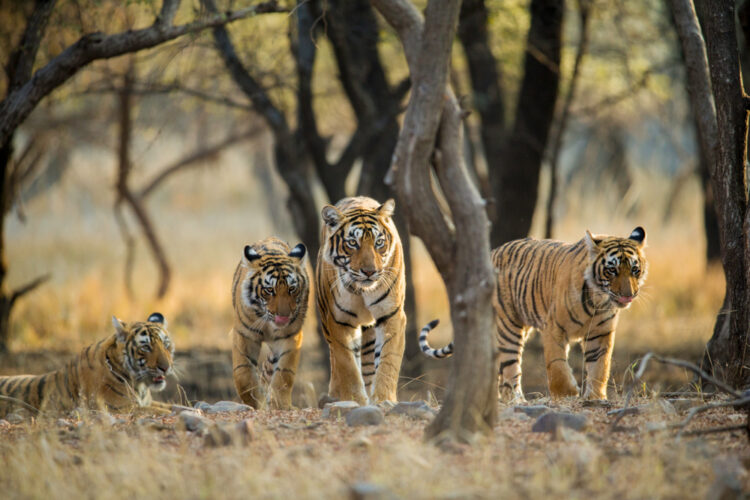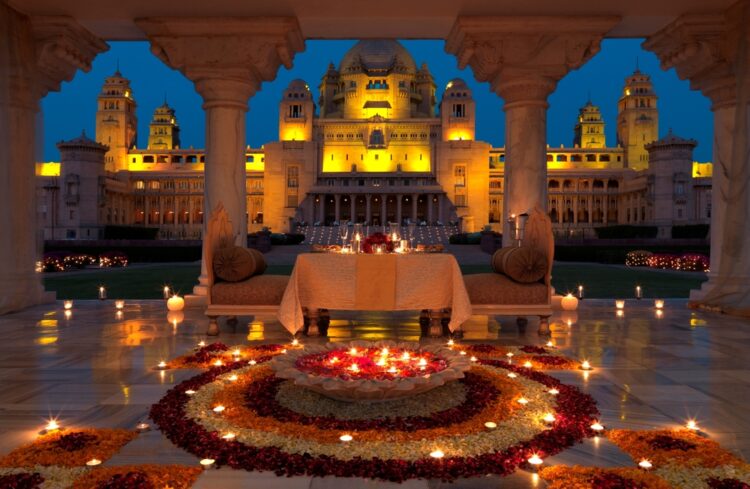The exotic land of Rajasthan is a showcase for India at its finest. From palaces and forts to tigers and temples, it bursts with color, history and incredible landscapes. It’s easy to understand why it’s one of the most visited states in country. I first fell in love with Rajasthan when I traversed the Golden Triangle of Delhi, Agra and Jaipur. Although my first visit was a mere taster (Jaipur is the only one of the three cities actually in Rajasthan), I knew I would be back to explore more of this enthralling region. I have since returned many times. Here are my nine highlights of Rajasthan.
- Jaipur – The Pink City
Jaipur, the capital of Rajasthan is known as The Pink City due to the dusty pink hue of its buildings. There is plenty to appreciate in this bustling Indian metropolis. Hawa Mahal is the city’s most iconic building. In days gone by, female members of the royal family would watch processions and activities taking place in the street below from the latticed sections above. A breeze would waft through, keeping the women cool, and the building consequently became known as the Palace of the Winds. The nearby City Palace is still used as a residence by the royal family but is open to the public. It houses a museum displaying an extensive selection of royal costumes, pashmina, and saris. Another popular attraction is the Janta Mantar, an 18th-century astronomical observation site that boasts the largest sundial in the world.
Lastly, the beautiful Amber Fort is located seven miles from the city. The architecture is a fusion of Rajput and Mughal in style and an exquisite place to explore. It’s easy to spend a day admiring its gardens, courtyards, and views over the countryside. Check out the spectacular hallway adorned with intricate mirror work.
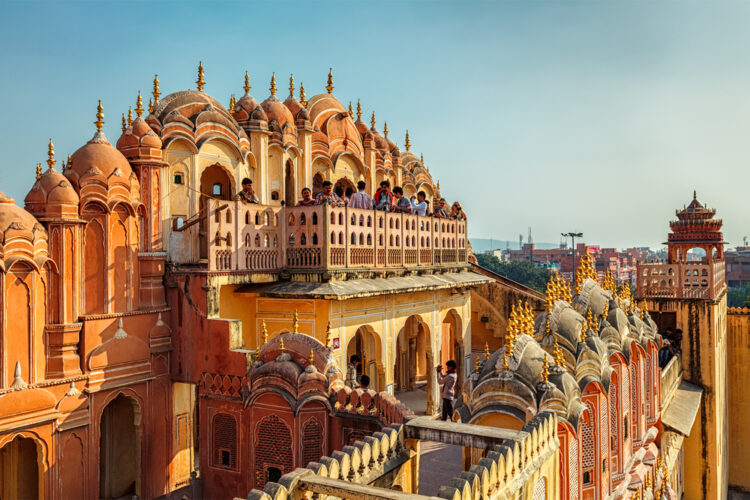
- Jaisalmer – The Golden City
Constructed from yellow sandstone and known as The Golden City, Jaisalmer rises above the Thar Desert like a mirage. With a magnificent 12th-century fort at its center, the city is exotic and unique. Within the fort walls, narrow atmospheric lanes are lined with havelis and temples. Don’t miss the superbly preserved Jain temples dating back to the 15th-16th centuries. Consisting of a complex of seven temples, they were built to protect the city from Mughal invaders. Jaisalmer was an important stop on the camel trade route, and taking a camel safari is a quintessential Jaisalmer experience. Beware – the touts are pretty full-on – they boarded my bus and were attempting to sell me a safari before I had even arrived in the city! It’s wise to research before arrival and choose a tour carefully. If riding a camel doesn’t appeal, you can take a jeep tour to the sand dunes and overnight in a desert camp.
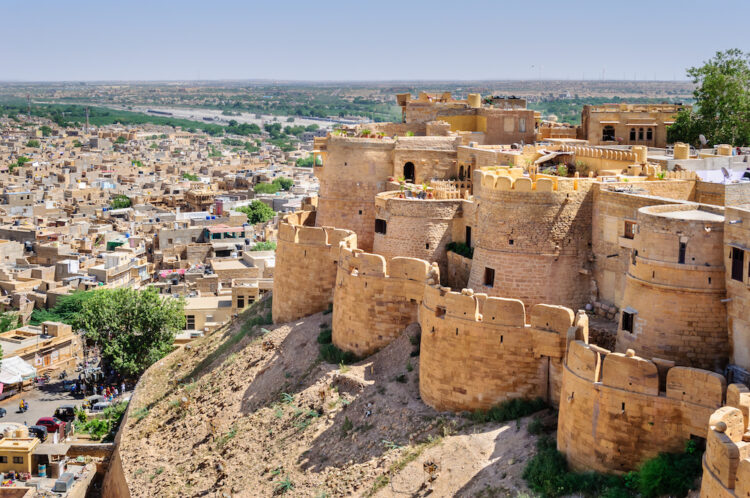
- Bikaner – The Heart of the Desert
Situated in the heart of the Thar Desert, on the trade route between central and western Asia, Bikaner is one of the state’s overlooked gems. It’s home to a splendid fort, a scattering of temples, and a fascinating historical quarter. Bikaner also hosts an annual camel fair and safaris into the desert can be arranged at the nearby camel farm. While the crowds head to Jaipur and Udaipur, foreign tourists largely have not discovered Bikaner. The locals are friendly and welcoming, and the city is relatively tout-free (a pleasant change when traveling in India!) Bikaner’s fort, Junagarh, is well-maintained and was built by Raja Rai Singh in the 15th century. The fort has intricately designed wall paintings with abundant glass and latticework. There are many nooks and crannies to explore, and a museum displays an array of royal artifacts. If you aren’t squeamish, trek out to the Karni Mata Temple, 26 miles from the city. Home to 20,000 scurrying rats, it’s good luck if a rat eats the food you offer!
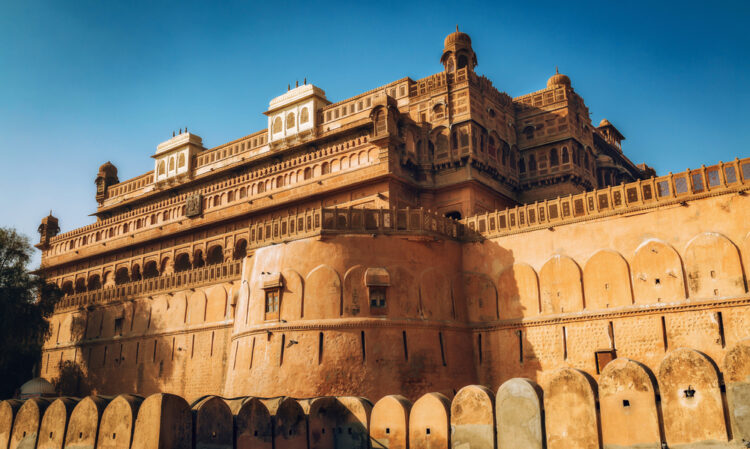
4) Jodhpur – The Blue City
Nicknamed the Blue City, Jodhpur is so-called because many of its buildings are painted in the color sacred to devotees of the Hindu God, Shiva. The main attraction is the imposing Mehrangarh Fort, which overlooks the city from a cliff top. The area at the back of the fort offers the best view of the mesmerizing sea of blue buildings. The fort is as impressive inside and out, containing a wide range of royal memorabilia and beautiful artwork. The rooms are decorative and colorful, especially Takhat Mahal – the party parlor. On the way back to the city, it’s worth stopping at Jaswant Thada, an ornately carved cenotaph built in honor of Mahajara Jaswant Singh II. Navchokiya, the blue labyrinth of streets beneath the fort is less busy than the old city and very photogenic. Another worthy stop is Umaid Bhawan, one of the last palaces to be built in India. Constructed in 1944, it has 347 rooms and is one of the largest private residences in the world.
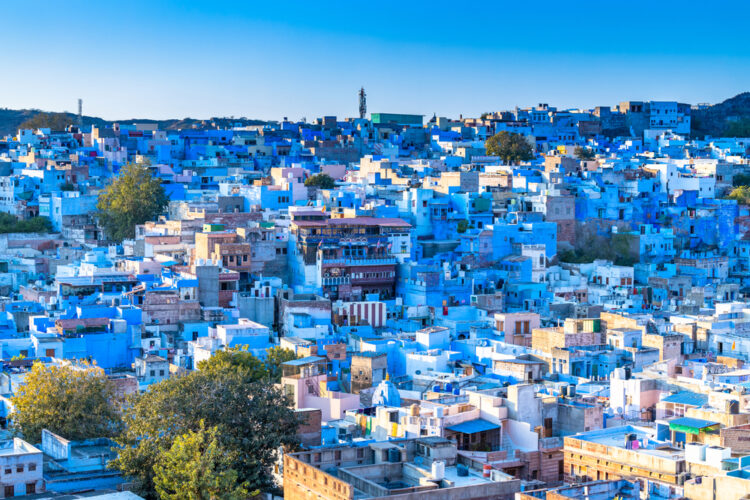
5) Mount Abu – Retreat from the Heat
A winding road leads to Rajasthan’s only hill station, Mount Abu, a popular retreat from the heat of the lowlands. Set in the Aravilla Mountains, 1220m above sea level, it’s a perfect location to connect with nature. Trekking, caving, rock climbing, and camping are all popular pursuits. Boat trips can be taken at Nakki Lake, surrounded by lush vegetation, mountains, and striking rock formations. One of the best hikes in the vicinity concludes at Dhrudhiya Waterfall, which is particularly spectacular during the monsoon season. Another trek passes the Guru Dattatreya Temple en route and culminates at the peak of Guru Sikha, from where there are panoramic views. A few miles from town, animal lovers can see leopards, sloth bears, and wolves at Mount Abu Wildlife Sanctuary. The five Dilwara Jain Temples, built between the 11th and 13th centuries and feature impressive carvings and marble work, are an architectural delight. Shopping in Mount Abu is a colorful experience. Locally produced handicrafts include sarees, bangles, puppets, quilts, and sandalwood. In the evening, crowds gather at Sunset Point to watch the sun sink over the mountains.
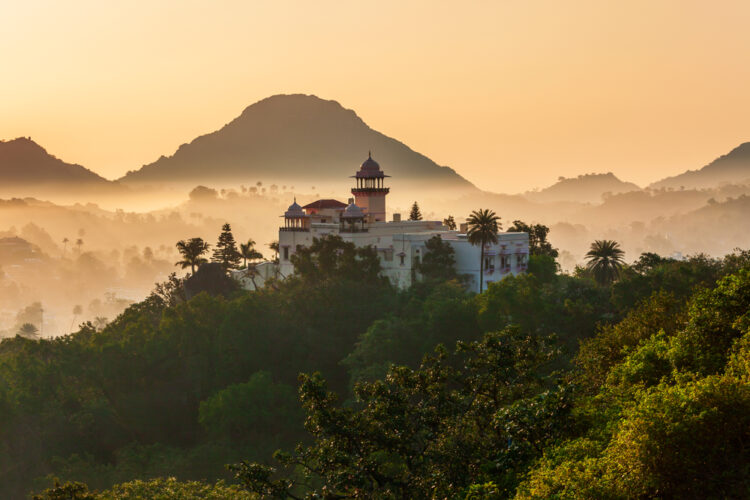
6) Small Town Vibes in Bundi
Bundi is one of the less visited Rajasthani towns, partly why it’s so appealing. A small but friendly enclave, it is devoid of hassle in more popular cities. As you explore the narrow streets, shopkeepers call out greetings and wave good-naturedly. Some shopfronts’ murals have striking and colorful images of Indian Gods. As with most towns in Rajasthan, Bundi has a palace. The approach at Taragahr Palace, known as Hathi Poi, means elephant gate, and visitors walk under a pair of elephant sculptures to enter. Although the building isn’t as well-maintained as Rajasthan’s better-known palaces, there are some remarkable murals to peruse and a treasure trove of paintings depicting Indian mythology.
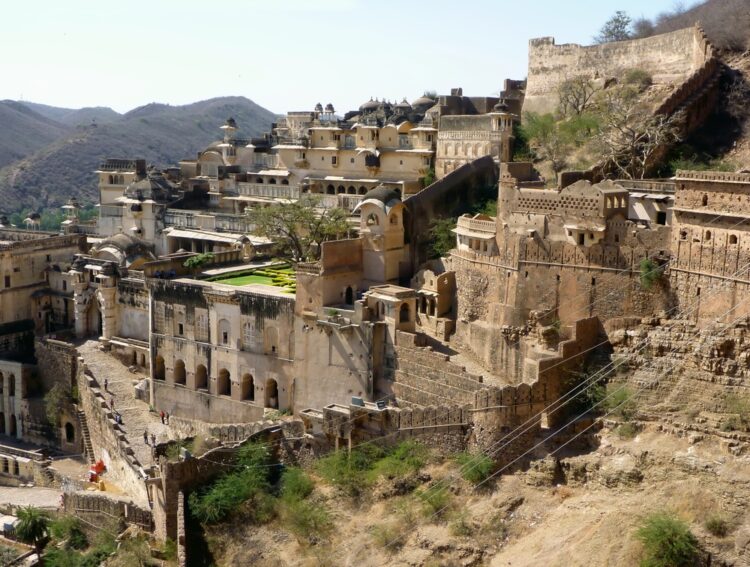
7) The Holy City of Pushkar
The town of Pushkar sits next to a holy lake and is famous for its camel fair every November for two weeks. The fair exudes a carnival-like atmosphere and attracts crowds of around 400,000 people. Tents and stalls are set up in the desert, and camel and horse traders arrive from all over India to do business. The event honors the Hindu God, Brahma. Even if you don’t make it to the camel fair, Pushkar is beguiling at any time of the year. Hindu pilgrims are drawn to the town to swim in the holy water and worship at one of the five hundred temples. Aarti (fire) ceremonies are held lakeside every evening when the sound of drumming, chanting, and belling can be heard from the ghats. Watching a ceremony as the sun goes down is a captivating experience. The town’s bazaar is a riot of color, crammed with hippie cafes, juice bars, and handicraft stalls. Being a holy town, Pushkar is vegetarian, and officially, alcohol is banned. However, bhang lassi laced with cannabis is widely available if you are tempted.
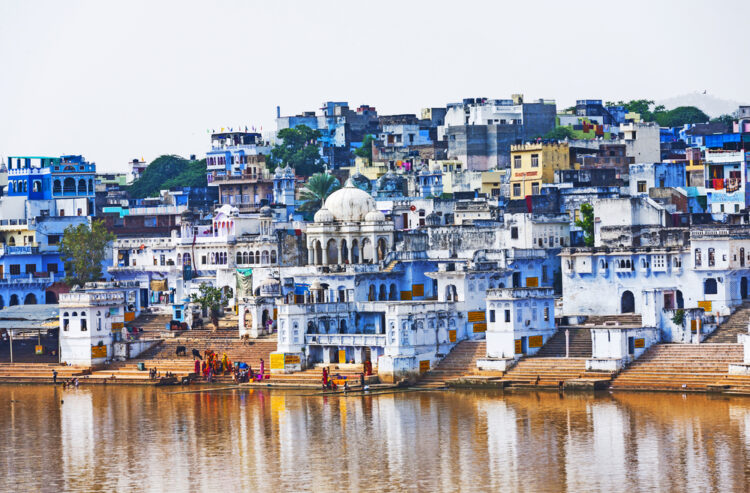
8) Magical Udaipur
The romantic lakeside setting of Udaipur is high on the agenda for most people who travel to Rajasthan. Known as the City of Lakes after the four lakes that it surrounds, it’s rich in Rajasthani architecture, culture, and history. The focal point of scenic Lake Pichola is the sumptuous Taj Palace Hotel, which has been featured in many movies, including James Bond’s Octopussy. It is at its most beautiful at night when the lights from the hotel glow on the water. The Udaipur City Palace and Museum is a highlight of any visit to Udaipur. The grandeur of the Mewer Palace is awe-inspiring, from the tinted glass and mirrorwork to the balconies, courtyards, and artwork. Also, check out the Monsoon Palace for sweeping lake views, especially magical at sunset. At Bagore-Ki-Haveli, an 18th-century haveli, nightly performances of traditional Rajasthani music and dance occur. The Haveli’s museum is fascinating, albeit somewhat creepy. One room is filled with colorful puppets, while another is dedicated to turbans. Each of the turbans is placed on a waxwork head, every one of them with their unique facial features.
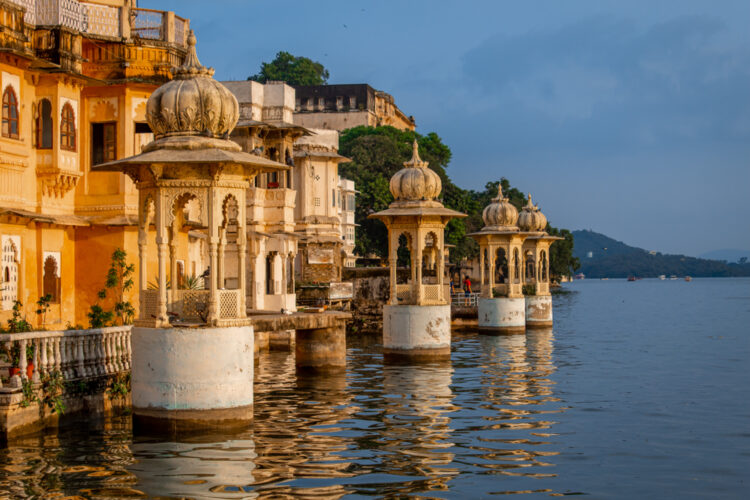
9) Tiger Spotting in Ranthambore National Park
If you want to see a tiger in the wild, Ranthambore National Park is one of the best places to head for. The nearest town to the park is Sawai Madhopur, where most people stay and arrange their safaris. The park is home to tigers, leopards, sloth bears, monkeys, and sambar deer. I booked a safari through my hotel and was lucky enough to view a tiger stalking a young deer at close range for an hour or so. Although the deer was initially oblivious, it swiftly escaped when it became aware of the tiger’s presence. It was an incredible experience and one I will never forget. In addition to tiger spotting, a majestic hilltop fort overlooks the park. Grey langurs can be seen as you make your way up the steps past colorful shrines. The fort is well-known for its Ganesh temple and is also home to a Jain temple and a mosque.
